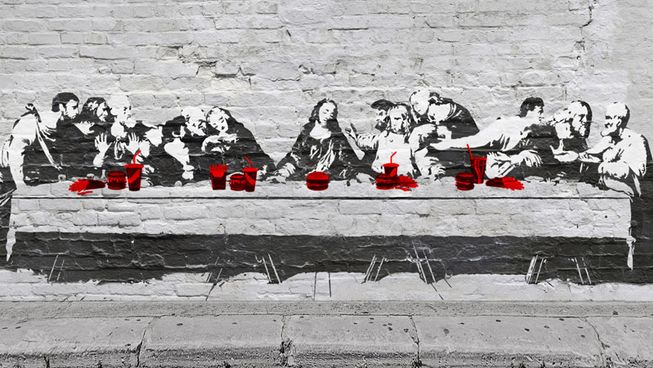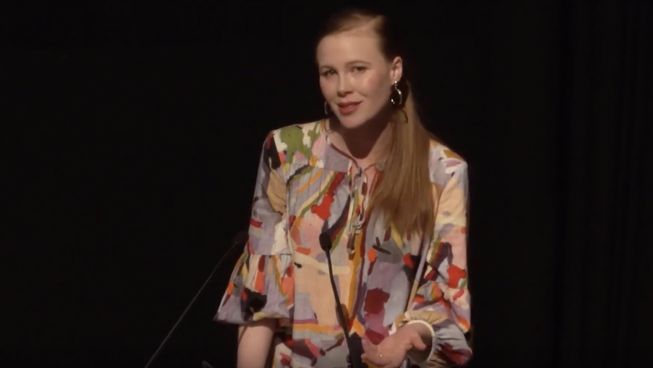Provocation or propaganda? (Part 2)

The story of Jesus, for those that might not know it, is one of reconciliation. God and humanity were somewhat estranged and so He sent His son in fragile human form to speak, forgive, heal, perform miracles and provoke God's people into transformation and ultimately relationship – a new relationship, beyond their previous religious law. Some rejects and rough sorts accepted the invitation, but the religious tortured and then executed him for heresy. In his death – a death he knew was coming – He claimed to be receiving the final punishment for humanity's eternity of brokenness and evil. And that it was a sacrifice that would reconcile humanity to God. Three days later He resurrected to prove it and later it was all written down by people who were there, and the four gospels of the Bible came into being. A very strange and divisive story.
But how does this make Jesus an artist?
I would like to propose that, if we view this story as an intentional provocation and as a public work of art inviting us to engage and respond - not sign up and blindly invest - that we might discover something new. I would like to suggest that having faith in Jesus is an act of creative collaboration with God, not merely an ideology we've bought into. This story is not passive. Once we've heard it, it implicates us and we're thrust into the middle of it. Whether we like it, whether we hate it, devour it or disbelieve it, we must respond to it.
An example: about a month ago, a book that I wrote was published, and it was released into the world. It was a memoir of certain aspects of my relationship with my own body and with God; the queer and sexual female body; the broken and abused female body; and the radical and transformative power of the Jesus story. Provocative to say the least. But of course, storytelling is provocative.
When someone presents a narrative, truth or fiction and implicates you in that story, it turns into something to either resist or receive. From the beginning, I had to be very clear with my publisher, and those that I needed to ask permission from, that this wasn't an historical text. My story was true, but it was not my attempt at a conclusive summary of events. I expressly reiterated that it was intended as a piece of art; an exploration of storytelling and poetic interpretation; truth-telling, maybe in its most dangerous form, to show the extraordinary distance between two points; to show the very secret and sacred thread I had uncovered in my own narrative. It was ugly in parts and it required a very strict lens and it omitted many people and events and dissected others, but it implicated many because it was about my body and bodies exist in relationships and even though all identities were protected, some of those who partook in my story saw themselves in the draft pages and were terrified at the thought of publication. Some people said, ‘I don't like the way that you've presented me.’ And some people said, ‘I don't agree with your version of the truth.’ We didn't remember events the same way. We didn't remember our relationships through the same lens. And how could we have? We have different bodies. We have different stories, but that didn't mean that my story wasn't true. My book is a specific piece of literature and its construction actually includes not only those who are mentioned within its pages, but also those that declined to be; those that I personally silenced or omitted; the bright highlights and the shadows. The whole truth is of course not only my perspective. I do not have a monopoly on it simply because I wrote my story down, the truth exists between us outside of the pages in the way that me and these other people have wrestled or reconciled or interacted over many, many years. Truth is not just what the book says, but it is still a valid truth. Perhaps so too it is with God's story.
The story of Jesus is not the world's whole story. It isn't even Jesus’ whole story. One of the books in the Bible clearly says that if everything that had happened had been written down, there wouldn't be room in the world for all the books that would be written. The story of Jesus we know is a brief and biased perspective, yes. But what if it's still true? We are implicated in this piece of truth-telling. We are written into its pages even when we do not read it; even when we deconstruct or disbelieve it and we must, if we want to be rigorous for the inner life that we're curating within ourselves, add the section on the rejection of Jesus into the story. Our acceptance or repentance makes it into the narrative too, like the people I needed to write about in my book in order to tell my truth. We are part of Jesus' story, whether we like it or not, whether we approve of how we are represented within it or not.
It isn't only the text of the Bible I am referring to, however, when I speak of Jesus’ artistry, though these scriptures are a fascinating mix of poetry and ancient storytelling and prophetic public art. Christians understand the Bible to be a long-curated collection of oral histories recorded by human hands and chosen with divine intention. Holy storytelling. It is remarkable that the word became flesh and then became word again, but the Bible is not the art I specifically want to refer to. The art I see and I feel and I understand when I behold the Jesus story, is the very way He lived. His life on earth was the public provocation that we still respond to today. Here's an artist who not only tells His stories as a gift, but one who lives the story and then allows the story to change everything. An artist who proposes that the radical act of living and then dying might be a provocation for societal transformation and that the beauty of that story might allow us to enter into it.
I've often lived from character to character in my work as an actor, allowing the stories of others to colour my own life, which I personally found quite dull and unimpressive. But when I came across the Jesus story, I began to get a hunger for my own character again, and a desire to live a life worthy of that mystery. I started to see a narrative arc in my own story. A long journey toward redemption and wholeness that I thought only existed in the movies I was cast in. To see the hero's journey in my own life, I needed to accept that I was unfinished, but I was going somewhere; that I wasn't always the hero and actually just a small part of a journey much bigger than just me. But even in my insignificance, I could still participate in the significant.
When I decided to write my life and body and faith as a work of art, I was forced to participate in actually living my life and body and faith as art. I couldn't explore or exaggerate my own story – to sell a book. I had to live slowly among community and observe reality, not the contrived. What I wish reality was. I had to find beauty in lack and doubt, and in failure. I had to wrestle with God and my body to honestly tell a story of reconciling with them. Perfection was no longer an option. Falseness was no longer an option. Advertising my life as a story worth following on Instagram, while I sat at home lonely was no longer an option. If it wasn't real, it had to go or I knew that the story that I was yearning to tell would simply be propaganda.
----------------
This blog is an abridged version of the talk by Anna McGahan at the 2019 Smith Lecture. Scroll down to access Part 1 of the talk.



